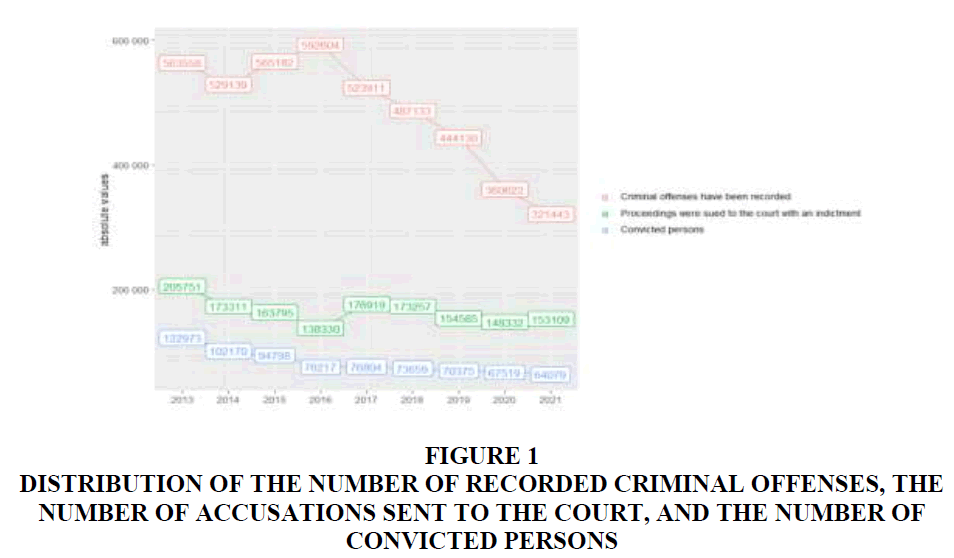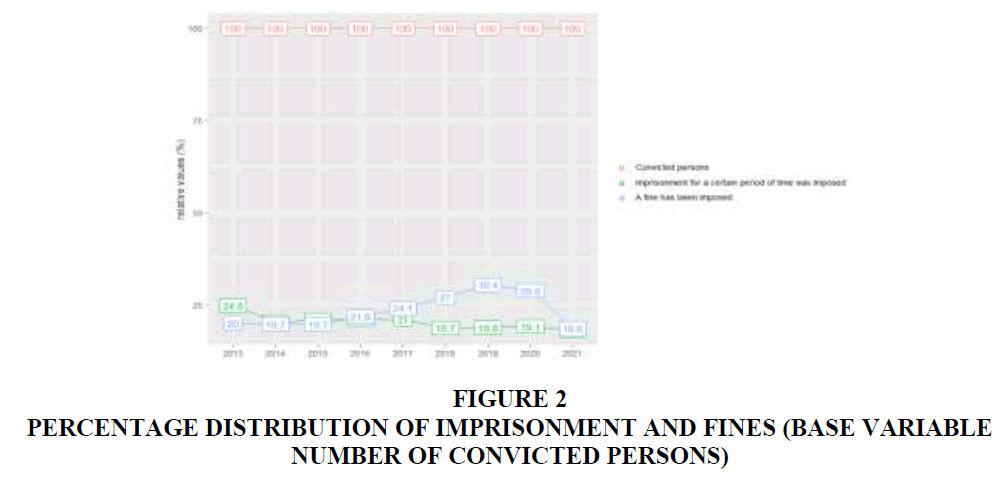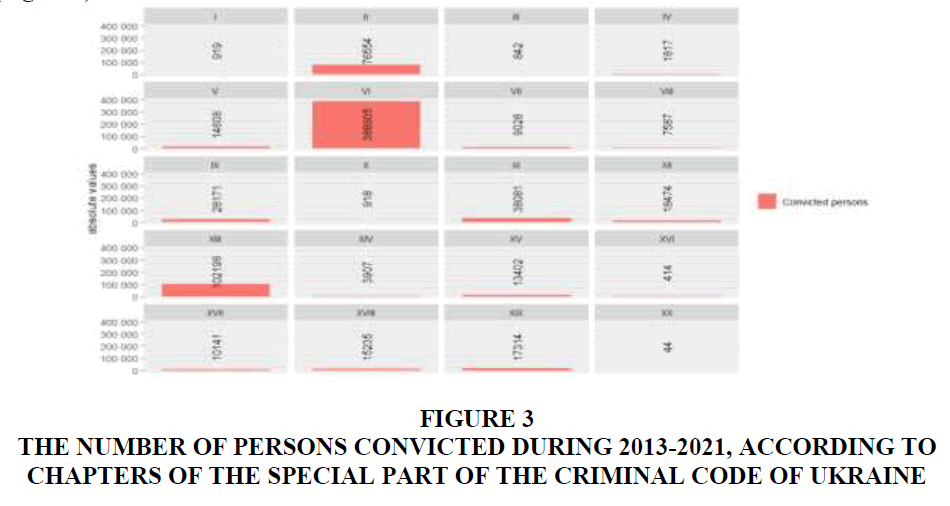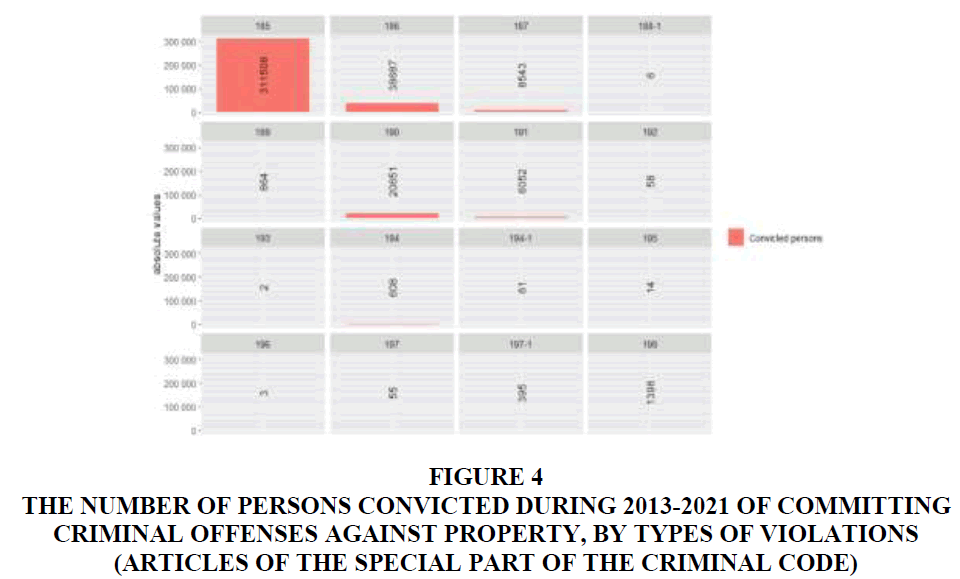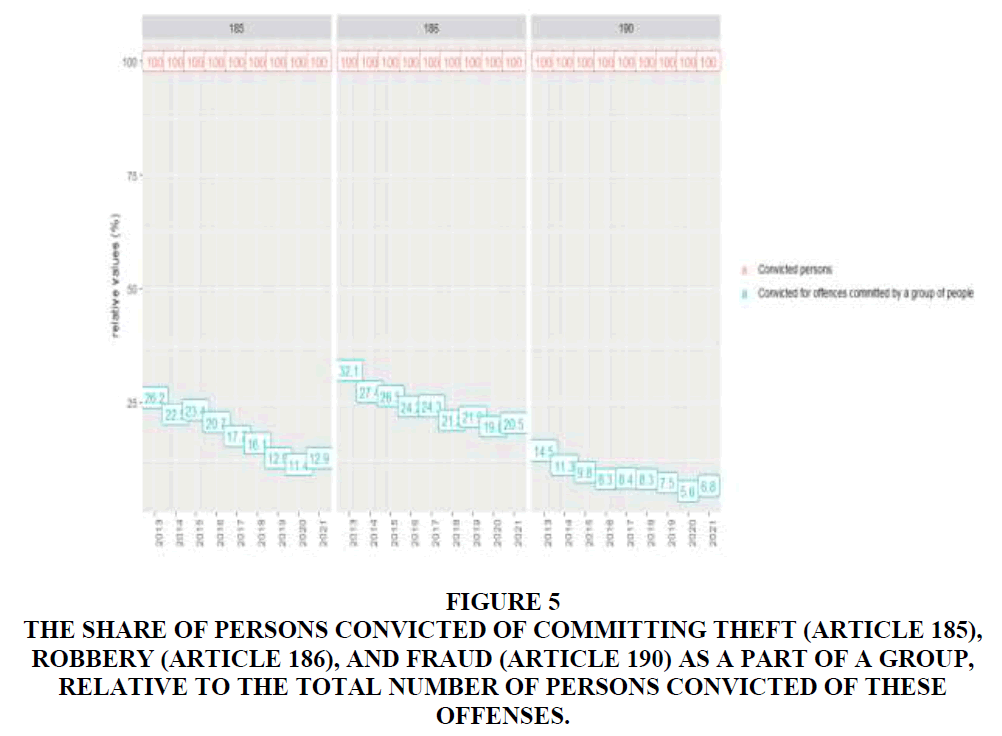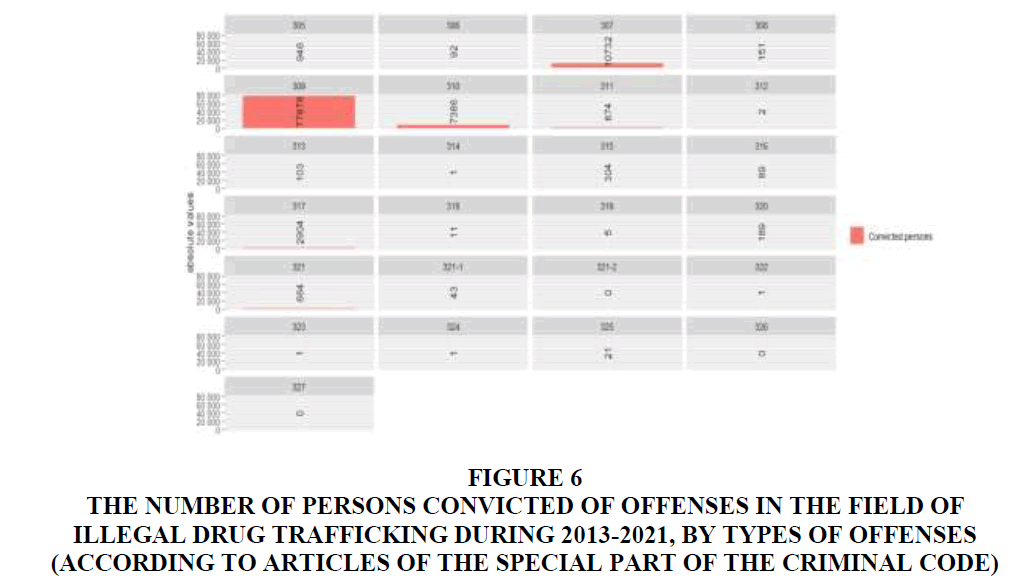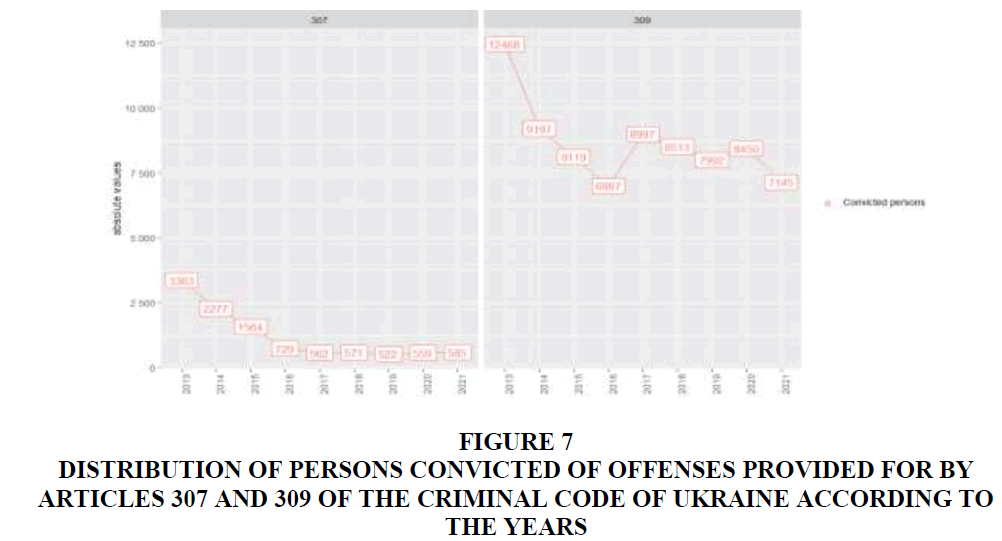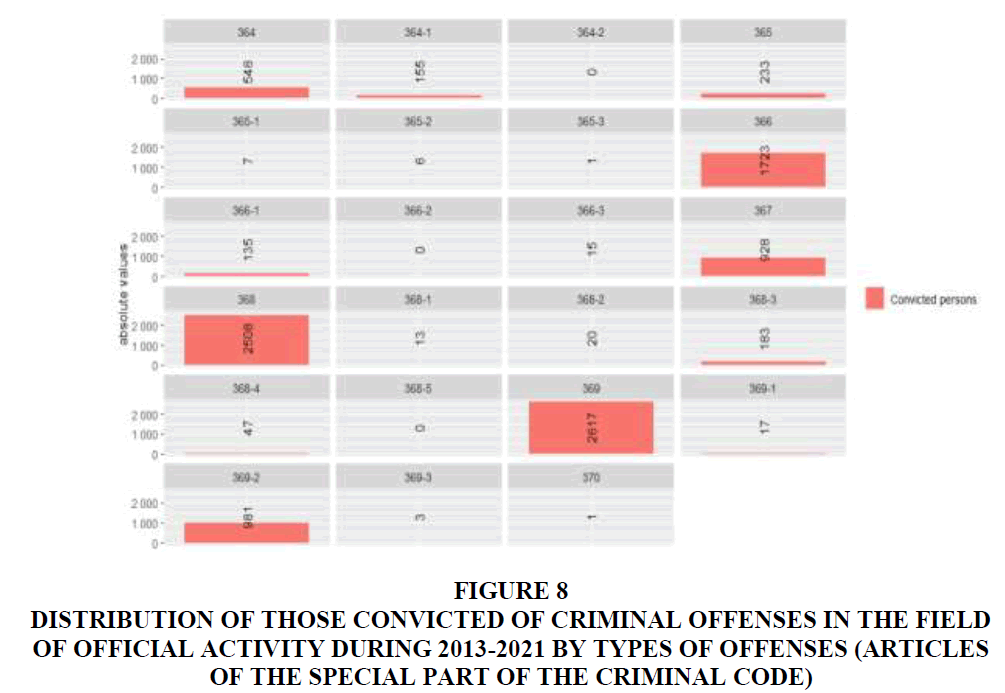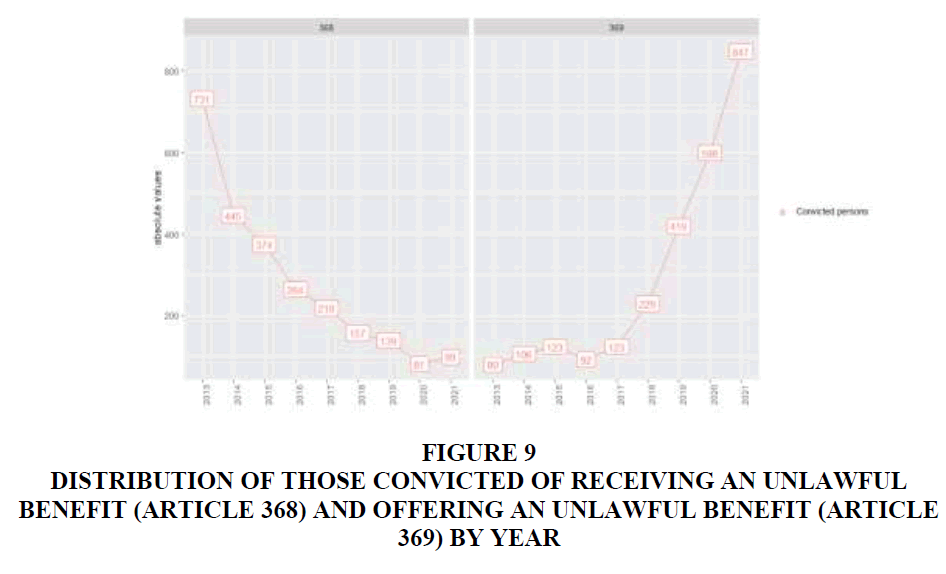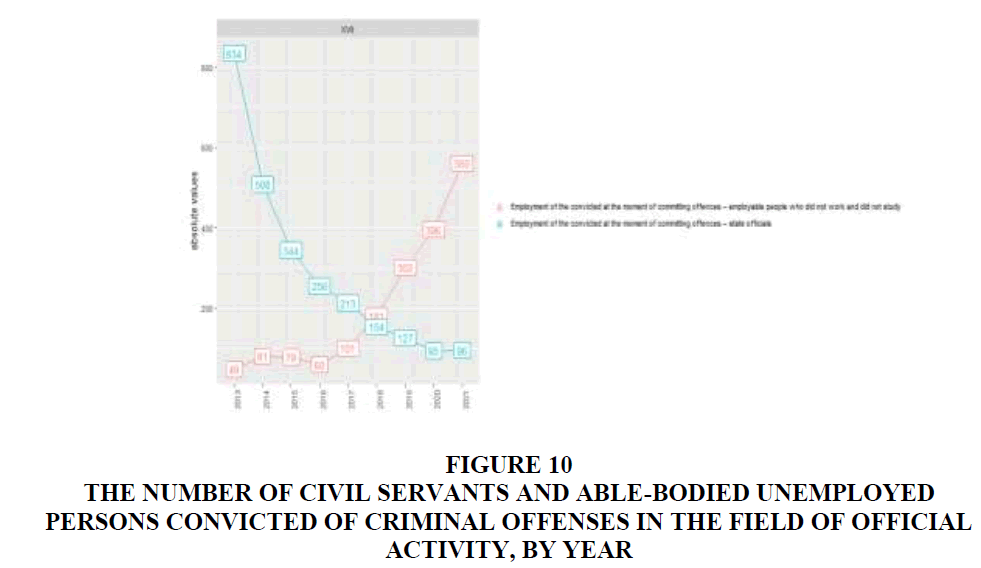Research Article: 2023 Vol: 26 Issue: 1S
Statistical Picture of the Countering Crime in Ukraine (2013-2021): A Reproducible Research
Mykola Karchevskyi, Luhansk State University of Internal Affairs
Citation Information: Karchevskyi, M. (2023). Statistical picture of the countering crime in Ukraine (2013-2021): A reproducible research. Journal of Legal, Ethical and Regulatory Issues, 26(2), 1-10.
Abstract
The ability of the community to evaluate the functioning of the criminal justice system is critical for democratic societies. It is the result of the systematic interaction of justice bodies with the community and is achieved by readiness for discussions and disputes, the openness of statistical reports, and the availability of results of specialized sociological research. In Ukraine, there are not enough tools for the analysis of public data on combating crime. This makes it impossible to conduct high-quality scientific research based on data, limits the ability to assess the effectiveness of law enforcement activities, leads to unbalanced changes in criminal legislation, and complicates the monitoring of criminal justice reform. With the use of Data Science methodology and R software, we have developed a tool which is called an interactive guide “Combating Crime in Ukraine: Info graphic”. The result of our work is a web application presented in open access. This web application integrates data contained in the annual reports of the Office of the Prosecutor General of Ukraine and the State Judicial Administration for the period from 2013 to 2021. The systematized application data characterize the process of applying the criminal legislation of Ukraine according to more than 100 parameters. The conducted research is fully reproducible, and scripts for data collection, cleaning, and processing are publicly available. With the use of the developed tool for working with official criminal statistics data, the following conclusions regarding the state of combating crime in Ukraine are offered: together with the gradual decrease in the number of registered criminal offenses, a decrease in the number of convicted persons and softening of punishments, which are appointed, there is an insufficient implementation of the public interest in the proper, effective functioning of the criminal justice system and a lack of constructive professional communication. In particular, there is a tendency to primitivize countermeasures against encroachment on property, encroachment in the field of illegal drug trafficking, and corruption.
Keywords
Data Science, Reproducible Research, Big Data, Crime Prevention, Criminal Statistics, Ukraine, Corruption, Primitivization of Crime Prevention.
Introduction
The increasing integration of technology into our lives has created unprecedented volumes of data on society’s everyday behaviour. Such data opens up exciting new opportunities to work towards a quantitative understanding of our complex social systems, within the realms of a new discipline known as Computational Social Science”. It is stated in the Manifesto of Computational Social Science (Conte et al., 2012). The methodology of this science is divided into such groups as automation of data collection, analysis of social systems, social geoinformation systems, modelling of social systems, etc. (Gilbert, 2010). The discipline uses computer simulations of a society, data collected from mobile and social networks, and online experiments involving hundreds of thousands of people, to obtain answers to questions that were previously impossible to examine. Mann aptly calls the results obtained by this science “a view of a society in high resolution” (Mann, 2016).
The integration of information technologies and social sciences gives rather interesting results (Edelmann et al., 2020). Information processing methods are effectively used to solve complex social problems such as the determination of features of the internal structure of social groups based on the network analysis (Fotoohi & Saeidi, 2019), automated processing of appeals in e-government systems (Iskandarli, 2020), algorithmization of fake news detection (Akinyemi et al., 2020), solving defence optimization problems (Hazra et al., 2017) etc.
Computational Social Science is considered to be an interdisciplinary field that includes Mathematics, Statistics, Data Science, and, of course, Social Science (Hox, 2017). In its turn, Data Science is defined as a set of fundamental principles for extracting information and knowledge from data (Provost & Fawcett, 2013).
The analysis of quantitative and qualitative indicators of criminal offenses is reasonably included in the basis of effective prevention of socially dangerous acts (Vozniuk, 2016). The suggested rationale for the separate existence of “evidence-based criminal law policy” is that “the implementation of the criminal law influence is possible only if the effectiveness of such an implementation is proven”. One of the vectors of the development of Applied Criminology is the introduction of new tools for working with big data (Holovkin, 2020). In this context, the use of Data Science methodology for research in the field of combating crime should be considered promising and in demand. This is exactly the kind of research we have conducted. Its result is the interactive guide “Combating Crime in Ukraine”. The reference book is presented in the form of a web application that integrates and provides an opportunity to analyse the data contained in the reports of the Office of the Prosecutor General of Ukraine and the State Judicial Administration for 2013-2021.
This paper aims to research the possibilities of analysing crime statistics data in the Data Science format, concluding on this basis regarding the trends of criminal law regulation in Ukraine.
Problem Formulation
The ability of the community to evaluate the functioning of the criminal justice system is critical for democratic societies. It is the result of the systematic interaction between justice bodies and the community. It is achieved by readiness for discussions and disputes, the openness of statistical reports, availability of results of specialized sociological research. There are not enough tools for analysis of public data on combating crime in Ukraine. This makes it impossible to conduct high-quality scientific research based on data, limits the ability to assess the effectiveness of law enforcement activities, leads to unbalanced changes in criminal legislation, and complicates the monitoring of criminal justice reform.
Scientific research based on the use of large volumes of data has become the subject of the debate about the replication crisis. The processes aimed at overcoming the problems caused by the crisis of replication can be considered as a way for science to new reputation advantages (Mede et al., 2021). Having overcome distrust of research results, science can consolidate its position in social discourse. A qualitatively new level of trust in scientific studies enables the possibility of reproducing research results, which are achieved through the use of Data Science methodology.
Research Methodology
The Research Methodology includes legal, algorithmic, and technical components. The legal one is that we consider the input data from the established and most common positions of legal science. In particular, this concerns the content of the terms “criminal offense”, “recorded offense”, “sentence that has entered into force”, etc. used in the study. The consideration of the crime prevention process is determined by the content of the analysed statistical reports. In general, the process of combating crime presented in statistical reports is as follows: 1) certain events are recorded by law enforcement agencies as requiring investigation within the framework of criminal proceedings; 2) as a result of the pre-trial investigation of such events, a decision may be made to refer the proceedings to the court; 3) in this case, four options are possible: sending materials with an indictment, sending a request for exemption from criminal liability, sending a request for the application of coercive measures of a medical nature, sending a request for the use of coercive measures of an educational nature; 4) consideration of proceedings in court ends with the entry into force of a certain court decision; 5) such decisions can also be of four types: on conviction of a person, on the acquittal of a person, on the application of coercive measures of a medical nature and on closing the case; 6) if a person is found guilty, the implementation of criminal responsibility can take place in repressive (imposing punishment) or liberal (exemption from punishment) forms.
The annual reports of the Office of the Prosecutor General of Ukraine and the State Judicial Administration of Ukraine presented in public access and used as input data are the result of the duties assigned to these bodies, provided for by the relevant regulatory documents.
The algorithmic component refers to the specifics of reproducible research. Data collection takes place in the way of downloading reports presented on the official online presentations of the Office of the Prosecutor General of Ukraine and the State Judicial Administration of Ukraine. Links to the reports have been added to the corresponding software scripts. Running scripts allows you to get local copies of the input data. Data transformation in this study consisted of converting reports into data suitable for automated processing (“clean” data). Data cleaning scripts were developed based on the analysis of the features of the structure of incoming reports. The execution of these scripts made it possible to obtain files containing only indicators of criminal law regulation specific to certain articles of the Special Part of the Criminal Code. These files lack elements that make automated processing difficult. Automated processing scripts create selections and generalizations for further visualizations from the “clean” data obtained at the previous stage. Visualization is carried out again through the execution of scripts that use the selections obtained at the previous stage and standard libraries for the graphical representation of data.
The technical component consists of the characteristics of the applied software. The R programming language and RSudio open source software development environment were used to perform the research tasks. The web application shell was developed using Shiny R. It is a software environment for creating interactive software products with a graphical interface based on the R programming language. The following R libraries have been used to develop the application: “shiny themes”, “shiny”, ”readxl”, “readr”, “DT”, “xlsx”, “tidyverse”, “textreadr”, “stringr”, “markdown”. Online applications present raw data, data suitable for automated processing, program codes for obtaining primary data, and their processing and visualization. All the used software products and data are freely available, which is an additional guarantee of the reproducibility of the conducted research.
Results and Discussion
The starting point of our analysis is the consideration of criminal law regulation in the context of the rational paradigm of criminal law. Based on the results of research into the problems of the effectiveness of criminal law regulation, the following principles for assessing the effectiveness of criminal law regulation have been formulated:
From the standpoint of the rational paradigm, the optimal state of criminal law is determined by its compliance with real social needs and the compliance of social expenditures for its implementation with the importance and protection of the guarded goods. At the same time, social expenses include not only material expenses for maintaining the law enforcement and judicial system, but also other social consequences of the application of criminal law i.e. criminalization of society, demographic, social, and consequences, etc.
Criminal law regulation is carried out at two levels: normative (legislative, law-making) and individual (law-enforcing), i.e. it includes both law-making and law enforcement. The subjects of criminal law regulation at the law-making level are the Verkhovna Rada of Ukraine, and the Constitutional Court of Ukraine (in terms of recognizing unconstitutional certain provisions of criminal legislation); at the law enforcement level there are courts of general jurisdiction.
Given the above, criminal law regulation is effective (in the context of the pragmatic paradigm) when the volume of actual social costs for its implementation corresponds to the volume of necessary social costs determined by law-making and law enforcement activities in the field of criminal law regulation.
Therefore, effective legislative decisions in the field of criminal law regulation should be considered to be those that provide a balance between the social significance of the protected goods and the reasonable amount of necessary social expenditures, namely the number of expenditures that the state and society can allocate to ensure criminal law regulation. Effective decisions at the law enforcement level of criminal law regulation should be considered to be those adopted under current legislation and requiring the implementation of social costs corresponding to the danger of a specific offense committed (Karchevsky & Kudinov, 2016; Karchevskiy & Kudinov, 2017).
The key trends characterizing criminal law regulation in Ukraine for the period from 2013 to 2021 are as follows: a decrease in the number of recorded proceedings and convicted persons (Figure 1), a decrease in the severity of the imposed punishments.
Figure 1 Distribution of the Number of Recorded Criminal Offenses, the Number of Accusations Sent to the Court, and the Number of Convicted Persons
A reduction in the severity of punishments consists in a gradual increase in the share of fines in the structure of punishments. Deprivation of liberty and a fine are traditionally the most widely used by Ukrainian courts. Until 2016, imprisonment was most often prescribed, but starting with 2016, fines prevail (Figure 2).
Figure 2 Percentage Distribution of Imprisonment and Fines (Base Variable Number of Convicted Persons)
It can be considered that all of the above indicate a steady increase in the effectiveness of the national law regulation. Less severe punishments ensure more effective crime prevention. There are reasons to predict a further steady decrease in crime. At the same time, this hypothesis explains far from all determined characteristics of the national criminal law regulation.
The largest number of persons were convicted of criminal offenses against property (chapter VI), in the field of drug trafficking (chapter XIII), and against life and health (chapter II) (Figure 3).
Figure 3 The Number of Persons Convicted During 2013-2021, According to Chapters of the Special Part of the Criminal Code of Ukraine
Among those convicted of criminal offenses against property, the largest numbers (Figure 4) were convicted of theft (Article 185), robbery (Article 186) and fraud (Article 190).
Figure 4 The Number of Persons Convicted During 2013-2021 of Committing Criminal Offenses Against Property, by Types of Violations (Articles of the Special Part of the Criminal Code)
The dynamics of those convicted of theft, robbery, and fraud are characterized by a decrease in the share of those convicted of criminal offenses committed as a part of groups (Figure 5). In the apparent absence of actual data on the reduction of the share of group encroachments on property, this trend may indicate an alarming simplification of the criminal law response to criminal encroachments on the property. The totality of court decisions reflects fewer and fewer actual encroachments on the property. Mostly "simple" cases of offenses committed by one person “reach” the court. At the same time, more dangerous forms of encroachment on the property (perpetrated by a group of persons) do not receive appropriate representation at the level of court decisions.
Figure 5 The Share of Persons Convicted of Committing Theft (Article 185), Robbery (Article 186), And Fraud (Article 190) as a Part of a Group, Relative to the Total Number of Persons Convicted of these Offenses.
One of the acute social problems is drug addiction. During the period of observation (2013-2021), the largest numbers of persons (Figure 6) were convicted of offenses under Articles 307 (illegal actions with drugs for the purpose of sale) and 309 (illegal actions with drugs without the purpose of sale).
Figure 6 The Number of Persons Convicted of Offenses in the Field of Illegal Drug Trafficking During 2013-2021, by Types of Offenses (According to Articles of the Special Part of the Criminal Code)
The analysis of the dynamics of convictions of these criminal offenses is quite informative (Figure 7). In 2013, 3, 363 people were convicted of illegal actions related to drug sales, and 12, 468 people were convicted of similar actions, but not related to drug sales. In 2021, the corresponding indicators were 7145 and 585 people, respectively.
Figure 7 Distribution of Persons Convicted of Offenses Provided for by Articles 307 and 309 of the Criminal Code of Ukraine According to the Years
That is, if in 2013 there were four facts of illegal actions not related to the sale for one fact of sale of drugs examined in court, and then in 2021 the corresponding ratio was 1 to 12. A conviction for the sale of narcotics requires a qualitatively different level of complexities of pretrial investigation and trial. Because of the above, we recognize that the dynamics of combating the second most common group of criminal offenses is such that it indicates insufficient implementation of the public interest in proper criminal justice, rather than a decrease in the level of corresponding crime.
Combating criminal offenses in the field of official activity. The analysis of the data shows that the majority were convicted for receiving (Article 368) or offering (Article 369) an unlawful benefit (Figure 8).
Figure 8 Distribution of Those Convicted of Criminal Offenses in the Field of Official Activity During 2013-2021 by Types of Offenses (Articles of the Special Part of the Criminal Code)
At the same time, during the studied period, the structure of convicted persons by criminal law qualification changed significantly. If until 2018, most people were convicted of receiving an illegal benefit, then starting in 2018-for offering an illegal benefit. The absolute values are even more telling: in 2013, 731 people were convicted of receiving an illegal benefit, 80 for offering; in 2021, 99 people were convicted of receiving an illegal benefit, and 843 for making an offer (Figure 9).
Figure 9 Distribution of those Convicted of Receiving an Unlawful Benefit (Article 368) and Offering an Unlawful Benefit (Article 369) by Year
The process was gradual; the corresponding trends of decrease/increase in the number of convicted persons were followed throughout the observation period. In addition, according to the SJA, since 2018, among those convicted of offenses under Chapter XVII of the Special Part, the number of “able-bodied people who did not work and did not study” is greater than the number of officials (Figure 10).
Figure 10 The Number of Civil Servants and Able-Bodied Unemployed Persons Convicted of Criminal Offenses in the Field of Official Activity, by Year
Our research of judicial practice (Karchevsky, 2022) shows that the vast majority of court decisions related to convictions for the offer of undue advantage (Article 369 of the Criminal Code) concerned the offer of a minor undue advantage to police officers (border guards) during the performance of their official duties as a part of daily duties (maintenance of public order, the performance of duties at the checkpoint across the state border, etc.). All of the court decisions involved a plea deal. Recognizing the importance of prosecuting the offering of bribes, it is difficult to accept that such a situation meets the social need to combat corruption. In this context, the decrease in the number of persons convicted of criminal offenses in the field of official activity hardly indicates the high effectiveness of the criminal legal countermeasures against corruption.
The given data to not exhaust examples of ambiguous trends in the actual practice of criminal law regulation in the context of existing social needs. Let us recall, for example, the ambiguous trends in the application of criminal legislation on encroachment on the bases of national security in the conditions of Russia’s armed aggression, which has been on-going since 2014, a decrease in the number of people convicted of illegal handling of weapons with a simultaneous increase in the number of closed cases in the conditions of the growing “black” market of weapons, etc.
Thus, as an antithesis to the previously expressed hypothesis about a generally positive assessment of trends and forecasts of crime prevention, the following interpretation of the research results can be formulated: due to the lack of constructive professional communication among law enforcement agencies, the prosecutor’s office and courts, the public interest in the proper functioning of the criminal justice system is not fully realized.
Unprofessional actions during the recording of criminal proceedings, pre-trial investigation, and court proceedings significantly reduce the effectiveness of combating crime. The primitivization of combating crime is observed. The spread of unprofessional actions creates a wide field of corruption, critically increasing the possibility of avoiding punishment. There are reasons to predict a fall in the level of public trust in social institutions that ensure compliance with laws and, as a result, an increase in crime.
In our opinion, both the first and second hypotheses partly show the real state of affairs. Indeed, there is a certain decrease in the level of crime, but at the same time, there are certain negative processes in the field of criminal justice. Minimizing the risks of the development of these processes, in addition to traditional measures (legislative, organizational, administrative, technical, infrastructural, etc.), involves, first of all, a change in the focus of professional communication, which should be directed not at the search for “weak links”, but at the effective implementation of the public interest in the proper functioning of the criminal justice.
Conclusion
1. Data Science methodology can be used for research in the field of criminal law regulation.
2. The possibility of reproducible research provided by this methodology significantly increases confidence in the results of scientific work.
3. The main trends in the fight against crime in Ukraine can be characterized as follows: along with the gradual decrease in the number of recorded proceedings, the decrease in the number of convicted persons, and the softening of the punishments imposed, there are an insufficient realization of the public interest in the proper and effective functioning of the criminal justice system, the primitivization of the fight against crime and lack of constructive professional communication.
4. There are risks of a decrease in the level of public trust in social institutions that ensure compliance with laws and, as a result, an increase in crime.
5. Prevention of the development of determined negative trends and minimization of relevant social risks requires not only legislative and administrative work. The rationalization of combating crime by making decisions based on the analysis of the actual state of affairs and their implementation in the field of practical criminal law policy is necessary. Changing the focus of professional communication is also required. It should be directed to the effective implementation of the public interest in the proper functioning of criminal justice.
References
Akinyemi, B., Adewusi, O., & Oyebade, A. (2020). An improved classification model for fake news detection in social media. International Journal of Information Technology and Computer Science, 12(1), 34-43.
Indexed at, Google scholar, Cross ref
Conte, R., Gilbert, N., Bonelli, G., Cioffi-Revilla, C., Deffuant, G., Kertesz, J., Loreto, V., Moat, S., Nadal, J., Sanchez, A., Nowak, A., Flache, A., San-Miguel M., & Helbing, D. (2012). Manifesto of computational social science. The European Physical Journal Special Topics, 214, 325-346.
Indexed at, Google scholar, Cross ref
Edelmann, A., Wolff, T., Montagne, D., & Bail, C.A. (2020). Computational social science and sociology. Annual Review of Sociology, 46, 61-81.
Indexed at, Google scholar, Cross ref
Fotoohi, S., & Saeidi, S. (2019). Discovering the maximum clique in social networks using artificial bee colony optimization method. Information Technology and Computer Science, 10, 1-11.
Indexed at, Google scholar, Cross ref
Gilbert, G.N. (2010). Computational social science. Sage.
Hazra, T., Kumar, C.R.S., & Nene, M.J. (2017). Strategies for searching targets using mobile sensors in defense scenarios. International Journal of Intelligent Systems and Applications, 9(5), 61-70.
Indexed at, Google scholar, Cross ref
Holovkin, B.M. (2020). Current and future criminology. Probs. Legality, 149, 168.
Indexed at, Google scholar, Cross ref
Hox, J.J. (2017). Computational social science methodology, anyone?
Indexed at, Google scholar, Cross ref
Iskandarli, G.Y. (2020). Applying clustering and topic modeling to automatic analysis of citizens’ comments in E-Government. International Journal of Information Technology and Computer Science, 12(6), 1-10.
Indexed at, Google scholar, Cross ref
Karchevskiy, M., & Kudinov, A. (2017). Experience of expert assessment of crisis phenomena in the field of criminal law regulation. The Scientific Bulletin of Association of Criminal Law of Ukraine, 1(8). 163-181.
Karchevsky, M.V. (2022). Fighting crime in Ukraine in data science format. Bulletin of Luhansk State University of Internal Affairs named after EO Didorenko, 2(98), 202-227.
Indexed at, Google scholar, Cross ref
Karchevsky, M.V., & Kudinov, A.S. (2016). Effectiveness of criminal law regulation in Ukraine. Bulletin of Luhansk State University of Internal Affairs named after EO Didorenko, 4(76), 101-114.
Mann, A. (2016). Computational social science. Proceedings of the National Academy of Sciences, 113(3), 468-470.
Indexed at, Google scholar, Cross ref
Mede, N.G., Schäfer, M.S., Ziegler, R., & Weißkopf, M. (2021). The replication crisis in the public eye: Germans’ awareness and perceptions of the (ir) reproducibility of scientific research. Public Understanding of Science, 30(1), 91-102.
Indexed at, Google scholar, Cross ref
Provost, F., & Fawcett, T. (2013). Data science and its relationship to big data and data-driven decision making. Big Data, 1(1), 51-59.
Indexed at, Google scholar, Cross ref
Vozniuk, А.А. (2016). Conceptual principles of prevention of socially dangerous acts. Scientific Bulletin of the National Academy of Internal Affairs, 2(99), 156–165.
Received: 19-Oct-2022, Manuscript No. JLERI-22-12702; Editor assigned: 21-Oct-2022, PreQC No. JLERI-22-12702(PQ); Reviewed: 02- Nov-2022, QC No. JLERI-22-12702; Revised: 28-Dec-2022, Manuscript No. JLERI-22-12702(R); Published: 04-Jan-2022
